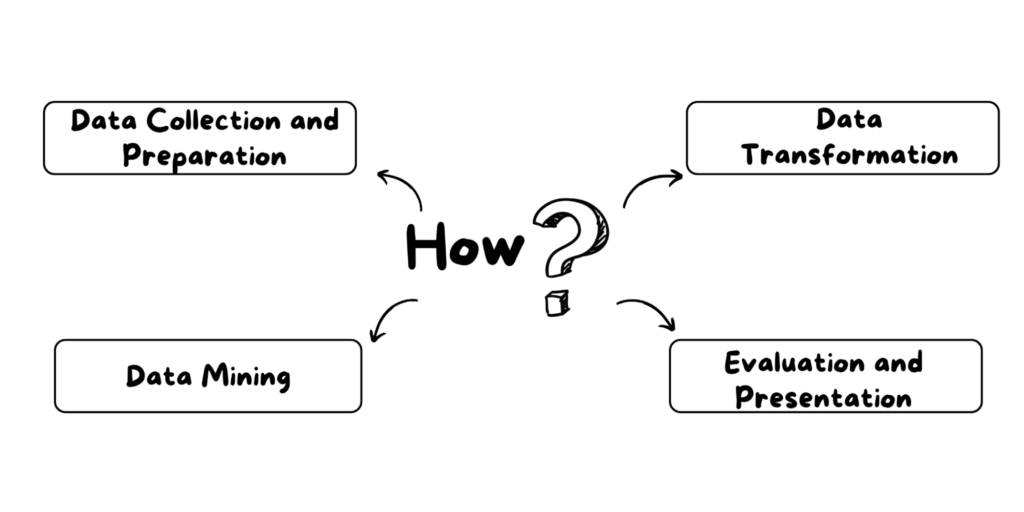What is Data Mining?
Data mining is a type of data analysis that involves searching through large amounts of information to find patterns and insights. Imagine having a giant library with thousands of books, but you just need to find specific facts or trends about one topic. Instead of reading every book, you can use special tools and techniques to quickly find the information you seek, i.e., data mining.
By identifying these patterns and insights, data mining helps businesses and organizations make better decisions, predict future trends, understand complex situations, and discover new data analysis methods. Keep reading to understand how data mining works, specific techniques you can use, and tools to expedite the process.
How Does Data Mining Work?
Data mining involves several steps to uncover patterns and insights from large data sets. Here’s a simplified breakdown of the process:

- Data Collection and Preparation:
- Collection: Gather data from various sources such as databases, sensors, the internet, or company records. This data can be structured (like numbers and dates) or unstructured (like text and images).
- Preparation (Cleaning and Integration): Clean the collected data to amend errors, handle missing values, and remove duplicates. Integrate data from different sources to create a comprehensive data set, ensuring consistency and accuracy.
- Data Transformation:
- Convert the data into a suitable format for analysis. This process includes normalizing data, summarizing it, and creating new features if necessary.
- Data Mining:
- Apply advanced algorithms and data analysis techniques to discover patterns and relationships within the prepared data. Common techniques include classification, clustering, association rule learning, regression, and anomaly detection.
- Evaluation and Presentation:
- Evaluate the discovered patterns to ensure they are meaningful and useful. Present the insights through reports, charts, or dashboards to make it easy for decision makers to interpret and use the information.
Each step in the process is crucial for ensuring the data mining efforts yield meaningful and actionable results.
Data Mining Techniques
Now that we better understand how data mining works, let’s review some analytical techniques you can use to uncover patterns within large data sets:
Classification
Classification is a technique that categorizes data into predefined classes or groups. For example, in a customer database, classification can help identify which customers are likely to buy a product and which are not based on their past behavior and demographic information.
Clustering
Clustering involves grouping objects so that objects in the same group (or cluster) are more similar than those in other groups. This technique is useful for market segmentation, where businesses can identify distinct customer groups and tailor their strategies accordingly.
Association Rule Learning
Association rule learning finds relationships between variables in large data sets. This technique is commonly used in market basket analysis to identify products that frequently co-occur in transactions. For example, it can reveal that customers who buy bread also often buy butter.
Regression
Regression analysis predicts a continuous outcome based on one or more input variables. For instance, it can help businesses forecast future sales based on historical sales data and other influencing factors like seasonality and market trends.
Anomaly Detection
Anomaly detection identifies rare items, events, or observations that differ significantly from most of the data and raise suspicions. This technique is essential in fraud detection, where unusual patterns can indicate fraudulent activity.
Decision Trees
Decision trees are used for both classification and regression tasks. They model decisions and their possible consequences, resembling a tree-like structure. This technique is intuitive and easy to interpret, making it popular for various business applications.
Neural Networks
Neural networks are computational models inspired by the human brain, capable of recognizing complex patterns and making predictions. They are particularly effective in tasks like image and speech recognition, where they can learn and improve from large amounts of data.
Text Mining
Text mining involves analyzing large collections of textual data to extract meaningful information. This technique is widely used in sentiment analysis, where businesses can gauge public opinion about their products or services by analyzing customer reviews and social media posts.
Data Mining Examples
Data mining is applied across various fields to uncover valuable insights and improve decision making. Here are some examples of how the data mining techniques we just covered are used in different industries:
Healthcare
-
- Patient Diagnosis: Analyzing patient records to predict diseases and suggest possible diagnoses based on symptoms and medical history.
- Treatment Effectiveness: Evaluating treatment plans to identify the most effective approaches for specific conditions.
Retail
-
- Market Basket Analysis: Identifying products that are frequently purchased together to optimize product placement and promotions.
- Customer Segmentation: Grouping customers based on purchasing behavior to tailor marketing strategies and improve customer satisfaction.
Finance
-
- Fraud Detection: Detecting unusual patterns in transaction data to identify potential fraudulent activities.
- Credit Scoring: Assessing credit risk by analyzing the financial history and behavior of loan applicants.
Telecommunications
-
- Churn Prediction: Predicting which customers are likely to switch to a competitor to allow companies to take proactive retention measures.
- Network Optimization: Analyzing network usage patterns to improve service quality and reduce downtime.
These examples demonstrate how data mining techniques can be applied across various sectors to derive actionable insights and drive strategic decisions.
Data Mining Tools
Data mining tools are software applications that process and analyze large data sets to discover patterns, trends, and relationships that might not be immediately apparent. These tools enable organizations and researchers to make informed decisions by extracting useful information. Some popular data mining tools include:
-
- Altair RapidMiner: Known for its flexibility and wide range of functionality, it covers the entire data mining process, from data preparation to modeling and evaluation.
- WEKA: A collection of machine learning algorithms for data mining tasks that are easily applicable to real data with a user-friendly interface.
- KNIME: Combines data access, transformation, initial investigation, powerful predictive analytics, and visualization within an open-source platform.
- Python (with libraries like scikit-learn, pandas, and NumPy): While Python is a programming language, its libraries are extensively used in data mining for sophisticated data analysis and machine learning.
- Tableau: A visualization tool with powerful data mining capabilities due to its ability to interactively handle large data sets.
These tools cater to a variety of users, from those who prefer graphical interfaces to those who are more comfortable coding their own analyses.
What Features Should I Look For?
Focusing on the most critical features can help streamline your decision when selecting a data mining tool. Here are the top features to consider based on general needs and the effectiveness they bring to your data mining projects:
-
- Analytical Techniques: Comprehensive support for predictive modeling, clustering, classification, and regression.
- Data Processing Capabilities: Strong abilities to handle, clean, and transform large data sets.
- Ease of Use: User-friendly interface suitable for both beginners and advanced users.
- Visualization Tools: Robust visualization options to easily interpret and communicate data insights.
- Scalability and Performance: High performance and scalability to manage growing data volumes.
- Integration Capabilities: Good integration with existing systems and various data formats.
These features are fundamental for a data mining tool to be effective and provide value in various scenarios, from academic research to business analytics.
Benefits of Data Mining
Data mining offers advantages across various industries, helping organizations make informed decisions and improve their operations. Here are some key benefits of data mining:
-
- Improved Decision Making: Provides actionable insights and enables predictive analysis for better strategic planning.
- Enhanced Customer Experience: Allows for the personalization of products and services, helping to retain customers and improve satisfaction.
- Increased Operational Efficiency: Optimizes processes, reduces costs, and improves resource allocation.
- Risk Management: Detects and prevents fraud and helps assess and mitigate risks effectively.
- Better Marketing Strategies: Creates targeted marketing campaigns and analyzes customer feedback to refine product and service offerings.
By leveraging the power of data mining, organizations can transform vast amounts of data into valuable knowledge, leading to more effective strategies.
Challenges of Data Mining
Data mining offers numerous advantages; however, it also comes with several challenges that you should consider to maximize its potential. Here are some potential issues:
-
- Data Quality Issues: Poor data quality can lead to incorrect analysis and unreliable results, and combining data from different sources can be complex and time consuming.
- Data Privacy and Security: Ensuring the privacy of sensitive information and protecting data from unauthorized access and breaches is essential and can be challenging.
- Complexity of Data: Handling vast amounts of heterogeneous data with many attributes requires advanced tools and techniques and can be computationally intensive.
- Technical Challenges: Choosing the right data mining algorithm for a specific problem and ensuring that data mining solutions can scale to accommodate growing data volumes can be difficult.
- Interpretation of Results: Understanding the patterns and insights discovered can be challenging without domain expertise, and translating these results into actionable strategies can be complicated.
Key Takeaways and Additional Resources
Data mining is crucial for extracting insights from large data sets to improve decision making and operations. Here’s what you should ultimately remember:
-
- Process: Involves data collection, preparation, exploration, modeling, and evaluation.
- Benefits: Improve decision making, customer experience, operational efficiency, risk management, and marketing.
- Challenges: Include data quality, privacy, complex data handling, technical issues, and results interpretation.
- Tools: Look for user-friendly interfaces, robust data handling, advanced analytics, performance, security, and good support.
Additional Resources
Enhance your data mining knowledge with these resources:
Books
-
- “Data Mining: Concepts and Techniques” by Jiawei Han, Micheline Kamber, and Jian Pei
- “Pattern Recognition and Machine Learning” by Christopher M. Bishop
Online Course
Websites and Blogs
Couchbase
